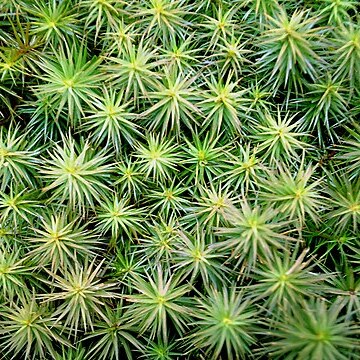Plants small to medium to fairly robust, gray-green to bluish green to reddish brown with age, in loose tufts, often forming extensive patches. Stems (1-)4-5(-10) cm, simple, brownish tomentose only near the base. Leaves 3-6(-8) mm, densely imbricate, ± erect and almost straight when dry, erect-spreading to widely spreading when moist; sheath oblong-rectangular, yellowish, tapering to the blade; blade slender, bluish green and nitid, rather flat, with sharply infolded margins; marginal lamina 5-7 cells wide, 1-stratose, entire or minutely crenulate, membranous and transparent, enclosing the lamellae and overlapping towards the apex; costa usually somewhat toothed distally, excurrent, forming a subulate, toothed awn, the awn reddish brown throughout or slightly decolorate at tip; lamellae bluntly crenate in profile, 6-8 cells high, the marginal cells in cross-section ovate to pyriform, thick-walled, ending in a distinct knob, smooth or rarely faintly papillose, the marginal cells of lateral lamellae (enclosed by the overlapping margins) ovoid and less strongly thickened; sheath cells 70-100 × 6-10 µm, narrowly rectangular (4-6:1), narrower toward the margin; cells of the broad marginal lamina transversely elongate, very thick-walled. Sexual condition dioicous; perigonial rosettes yellowish to reddish green; perichaetial leaves longer than the foliage leaves, long-sheathing, the blade almost obsolete, ending in a slender yellowish or hyaline awn. Seta (1-)3-5 cm, stout, yellowish to reddish brown. Capsule 2.5-5 mm, rectangular, longer than wide (1.5-2:1), reddish brown to dark brown, glaucous when fresh, suberect, becoming horizontal when mature, sharply 4-angled and prismatic; peristome 200-240 µm, divided to 0.6-0.8, the teeth 64, keeled at back. Calyptra whitish to light brown, covering the capsule. Spores 6-10(-12) µm.
More
Stems to 15.5 cm tall. Leaves tightly appressed when dry, erect-spreading when moist, 4.2-8.5 mm long; lamina 0.4-0.6 mm wide; abaxial cells with distinctly incrassate outer walls; margin entire, tightly incurved, partly covering adaxial lamellae, unistratose, 5-11 cells wide, with short broad cells; sheathing base gradually widened; costa forming a brown to hyaline arista with apical abaxial teeth; lamellae 32-52, on adaxial surface of lamina, 5-8 cells high, distinctly crenate by upper margin, with apical cells of central lamellae pyriform in cross-section and with the incrassate outer wall forming a distinct knob. Urn 3.7-6.6 mm long, 2.0-3.6 mm wide. Spores 9-14 µm diam.
Plants medium-sized to large, in tufts. Stems up to 30 mm long. Leaves scale-like below, imbricate and erect when dry, wide-spreading to squarrose when wet, 6-8 mm long; apex subulate; base oblong, sheathing, shiny; margins entire, broadly involute, covering the upper leaf surface; costa excurrent as rough, reddish awn; lamellae 6-8 cells high, terminal cell pyriform, incrassate. Upper laminal cells at margins transversely elongate. Capsule 4-angled, rectangular. Calyptra hairy.

